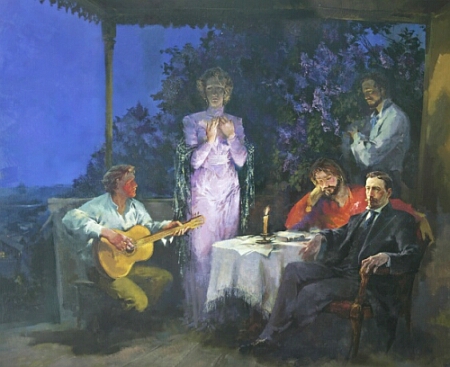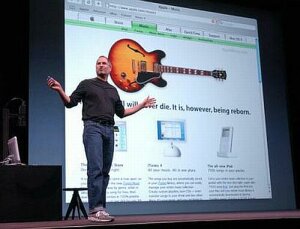IDM – Intelligent Dance Music
 IDM – Intelligent Dance Music Experimental direction in electronic music. Its founder is considered the English musician Richard D. James, known as Aphex Twin. He easily turned away from industrial synthesizers, and with the help of his own electronic devices he managed to get a new sound in electronic music. Its sound from ragged drums, modulated noises, high-frequency whistles and congested sounds inspired a large number of followers of musicians. And this music has become at the same time very noticeable and imperceptible to the masses, while it manages to balance on the verge of pop music and avant-garde. Every year, convening under its banners more and more listeners, those for whom the dance music is not quite close, and for whom academic electronics are far away.
IDM – Intelligent Dance Music Experimental direction in electronic music. Its founder is considered the English musician Richard D. James, known as Aphex Twin. He easily turned away from industrial synthesizers, and with the help of his own electronic devices he managed to get a new sound in electronic music. Its sound from ragged drums, modulated noises, high-frequency whistles and congested sounds inspired a large number of followers of musicians. And this music has become at the same time very noticeable and imperceptible to the masses, while it manages to balance on the verge of pop music and avant-garde. Every year, convening under its banners more and more listeners, those for whom the dance music is not quite close, and for whom academic electronics are far away.
We can assume that the style originated in the 89th year. The term Intelligent Dance Music itself was coined in the depths of computer networks in about the 93rd year after the English label Warp Records released a compilation of “Artificial Intelligence” featuring The Dice Man (Aphex Twin), Autechre, Speedy J, etc. This was followed by a compilation of “Artificial Intelligence II”, with the participation of B12, Link, Beaumont Hannant, Speedy J, Polygon Window, Seefeel, Autechre. The music of these musicians did not fit into the framework of any one already existing style. It was called and New Electronica, and Intelligent Techno, and Experimental Electro. In computer networks, this incomprehensible experimental techno music was rather quickly dubbed Intelligence Dance Music. The word intelligent hinting that not everyone can understand this music, the word dance hinting at its hidden humor (try dancing to it), and the only thing that could be said with full seriousness is that this is really music. Music with its own special melodies, sometimes very childish and simple, and sometimes completely unchildren and fascinating.
The musicians themselves who create this music often disagree with this definition. Indeed, quite loudly declare that your music is intelligent, and many others do not. As a result, these disputes only generate new names for the style, and the IDM abbreviation remains in the circulation of those who have long loved this music. But it’s not about the label, it’s about the music. And something new still appears in it, because its development is driven by experiment. The experimentation of this music can manifest itself literally in everything: in melodies, in rhythms, in sounds, in schemes for constructing compositions. At one time, people from Cosmic Baby to Cabaret Voltaire, from Banco De Gaia to Goldie, from Portishead to Underworld fell under the definition of this style. But it was a long time ago, since the music has significantly made a step forward, many other stylistic labels with clear frames have appeared. I got these frames and IDM label. Currently, there are several major music trends within the framework of IDM. About them will be discussed below.
Easy forms IDM. Beautiful electronic melodies, often very simple ones, are necessarily present in the compositions of this direction. Melodies can be many, they can replace each other, merge in unexpected ways, unexpectedly arise and become silent. They may have an ambient load like Autechre, or maybe a dance like Orbital. The next element of such music is a rhythm built on knocks and breaks. Percussion sounds can be pretty standard like that of Orbital, or they can be completely non-standard like Aphex Twin. It is possible to use lightly overloaded and dirty percussion sounds, crunches, etc.
Heavy forms IDM. The main distinctive feature of this direction is heavy overloaded and ragged percussion sounds in rhythms. The rhythms are again set on breaks and knocks, but it happens that the overloaded straight bit 120-140 bpm is used. In particular, Aphex Twin has early straight heavy tracks, which are considered classics of English hardcore. The rhythm in such music always prevails over the melody, if of course the melody is generally present. It is this IDM direction that is closest to industrial noise music forms.
The main difference of these noise structures in the sound. You can’t hear the brutal roar and the inherent industrial works. In IDM, everything is done with mathematical precision. Every sound, every break is thought out, and the pounding of pieces of iron, the roar of chainsaws and concrete mixers are synthesized by computers. As well as musicians sometimes simply compete in the use of fuzz, overdrive and distortion, for the sake of sports interest and their own razvechevoy mood. In general, no ideology.
Classic forms of IDM. In this direction, the melodic sides of light forms and the rhythmic sides of heavy forms are used. The classic track of this direction is the track “On” by Aphex Twin. The war of heavy, overloaded rhythms and beautiful electronic melodies. It is never clear who among them will win this time, but it is always clear that the melody will remain in our hearts forever.




